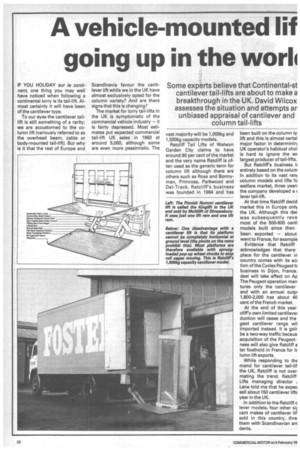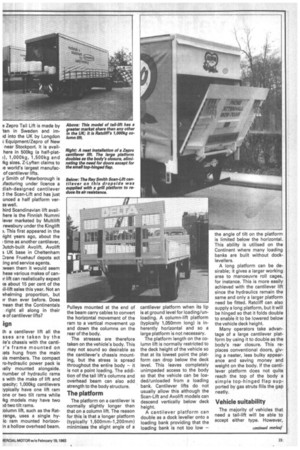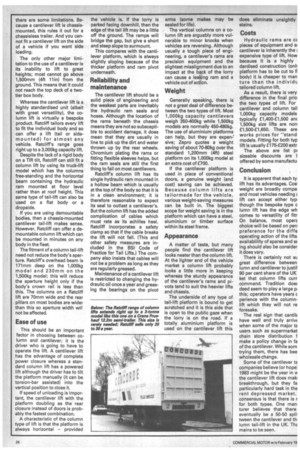A vehicle-mounted lif going up in the worll
Page 24

Page 25

Page 26

If you've noticed an error in this article please click here to report it so we can fix it.
Some experts believe that Continental-st cantilever tail-lifts are about to make a breakthrough in the UK. David Wilcox assesses the situation and attempts an unbiased appraisal of cantilever and column tail-lifts
IF YOU HOLIDAY sur le continent, one thing you may well have noticed when following a continental lorry is its tail-lift. Almost certainly it will have been of the cantilever type.
To our eyes the cantilever taillift is still something of a rarity; we are accustomed to the column lift (variously referred to as the overhead beam, cable or body-mounted tail-lift). But why is it that the rest of Europe and Scandinavia favour the cantilever lift while we in the UK have almost exclusively opted for the column variety? And are there signs that this is changing?
The market for lorry tail-lifts in the UK is symptomatic of the commercial vehicle industry — it is fairly depressed. Most estimates put expected commercial tail-lift UK sales in 1983 at around 5,000, although some are even more pessimistic. The vast majority will be 1,000kg and 1,500kg capacity models.
Ratcliff Tail Lifts of Welwyn Garden City claims to have around 90 per cent of the market and the very name Ratcliff is often used as the generic term for column lift although there are others such as Ross and Bonnyman, Primrose, Parkwood and Del-Track. Ratcliff's business was founded in 1964 and has been built on the column ty lift and this is almost certai major factor in determinini UK operator's habitual choi is hard to ignore the w( largest producer of tail-lifts.
But Ratcliff's business b. entirely based on the colum In addition to its vast rani column models and lifts ft welfare market, three year the company developed a c lever tail-lift.
At that time Ratcliff decid market this in Europe only the UK. Although this dec was subsequently reve most of the 500-600 canti models built since then been exported — about went to France, for example
Evidence that Ratcliff acknowledges that there place for the cantilever in country comes with its acc tion of the Cycles Peugeot U. business in Dijon, France. deal will take effect on Ap The Peugeot operation man tures only the cantilever and with an annual outpi 1,800-2,000 has about 40 cent of the French market.
At the end of this year cliffs own limited cantilever duction will cease and the geot cantilever range wil imported instead. It is goir be a two-way traffic becausi acquisition of the Peugeot ness will also give Ratcliff a ter foothold in France for it: lumn lift exports.
While responding to the mand for cantilever tail-lif the UK, Ratcliff is not over• mating the trend. Ratcliff Lifts managing director Lane told me that he expec sell about 150 cantilever liftE year in the UK.
In addition to the Ratcliff c lever models, four other s4 cant makes of cantilever lit sold in this country, threi them with Scandinavian arrl dents. e Zepro Tail Lift is made by ten in Sweden and irnK1 into the UK by Longdon c Equipment/Zepro of New near Stockport. It is availhere in 500kg (a half-plat1), 1,000kg, 1,500kg and Ikg sizes. Z-Lyften claims to le world's largest manufacof cantilever lifts.
y Smith of Peterborough is fracturing under licence a dish-designed cantilever i the Scan-Lift and has just unced a half platform verEIS well.
hird Scandinavian lift availhere is the Finnish Nummi lever marketed by MuItilift rewsbury under the Kinglift ). This first appeared in the light years ago, about the time as another cantilever, )utch-built Avolift. Avolift 3 UK base in Cheltenham L'aene Fruehauf depots act ing and service agents.
:ween them it would seem hese various makes of can1r lift can realistically expect ce about 15 per cent of the sales this year. Not an vhelming proportion, but 1r than ever before. Does nean that the Continentals right all along in their e of cantilever lifts?
ign
th a cantilever lift all the sses are taken by the ;le's chassis with the cantir's frame mounted on [ets hung from the main ;is members. The compact ro-hydraulic power pack is lally mounted alongside. number of hydraulic rams s with the make of lift and ipacity; 1,000kg cantilevers typically have one lift ram one or two tilt rams while kg models may have two id two tilt rams.
:olumn lift, such as the Ratrange, uses a single hyic ram mounted horizonin a hollow overhead beam. Pulleys mounted at the end of the beam carry cables to convert the horizontal movement of the ram to a vertical movement up and down the columns on the rear of the body.
The stresses are therefore taken on the vehicle's body. This may not sound so desirable as the cantilever's chassis mounting, but the stress is spread throughout the entire body — it is not a point loading. The addition of the tail lift's columns and overhead beam can also add strength to the body structure.
The platform
The platform on a cantilever is normally slightly longer than that on a column lift. The reason for this is that a longer platform (typically 1,500mm-1,200mm) minimises the slight angle of a cantilever platform when its lip is at ground level for loading/unloading. A column-lift platform (typically 1,050mm long) is inherently horizontal and so a large platform is not necessary.
The platform length on the column lift is normally restricted to the deck height of the vehicle so that at its lowest point the platform can drop below the deck level. This leaves completely unimpeded access to the body so that the vehicle can be loaded/unloaded from a loading bank. Cantilever lifts do not usually allow this although the Scan-Lift and Avolift models can descend vertically below deck height.
A cantilever platform can double as a dock leveller onto a loading bank providing that the loading bank is not too low — the angle of tilt on the platform is limited below the horizontal. This ability is utilised on the Continent where many loading banks are built without docklevellers.
A long platform can be desirable; it gives a larger working area to manoeuvre roll cages, for instance. This is more easily achieved with the cantilever lift since the hydraulics remain the same and only a larger platform need be fitted. Ratcliff can also supply a long platform, but it will be hinged so that it folds double to enable it to be lowered below the vehicle deck height.
Many operators take advantage of a large cantilever platform by using it to double as the body's rear closure. This replaces conventional doors, giving a neater, less bulky appearance and saving money and weight on the body. If the cantilever platform does not quite reach the top of the body a simple top-hinged flap supported by gas struts fills the gap neatly.
Vehicle suitability
The majority of vehicles that need a tail-lift will be able to accept either type. However, there are some limitations. Because a cantilever lift is chassismounted, this rules it out for a chassisless trailer. And you cannot fit a cantilever lift on the side of a vehicle if you want side loading.
The only other major limitation to the use of a cantilever is its inability to lift to great heights; most cannot go above 1,500mm (4ft 11in) from the ground. This means that it could not reach the top deck of a twotier box body.
Whereas the cantilever lift is a highly standardised unit (albeit with great versatility), the column lift is virtually a bespoke product. Ratcliff tailors every lift to fit the individual body and so can offer a lift (tail or sidemounted) for almost any vehicle. Ratcliff's range goes right up to a 3,000kg capacity lift.
Despite the lack of a rigid body on a TIR tilt, Ratcliff can still fit a column lift by using its truck-lift model which has the columns free-standing and the horizontal beam containing the hydraulic ram mounted at floor level rather than at roof height. This same type of tail-lift can also be used on a flat body or a dropside.
If you are using demountable bodies, then a chassis-mounted cantilever tail-lift makes sense. However, Ratcliff can offer a demountable column lift which can be mounted in minutes on any body in the fleet.
The fitment of a column tail-lift need not reduce the body's aperture. Ratcliff's overhead beam is 171mm deep on the 1,000kg model and 2 30mm on the 1,500kg model; this will reduce the aperture height only if the body's crown rail is less than this. The columns on a Ratcliff lift are 70mm wide and the rear pillars on most bodies are wider than this so aperture width will not be affected.
Ease of use
This should be an important factor in choosing between column and cantilever; it is the driver who is going to have to operate the lift. A cantilever lift has the advantage of complete power closure whereas a standard column lift has a powered lift although the driver has to tilt the platform manually (it can be torsion-bar assisted) into the vertical position to close it.
If speed of unloading is important, the cantilever lift with the platform doubling as the rear closure instead of doors is probably the fastest combination.
A characteristic of the column type of lift is that the platform is always horizontal — provided the vehicle is. If the lorry is parked facing downhill, then the edge of the tail lift may be a little off the ground. The ramps will bridge the gap, but give a short and steep slope to surmount.
This compares with the cantilever platform, which is always slightly sloping because of the thicker platform and ram pivot underneath.
Reliability and maintenance
The cantilever lift should be a solid piece of engineering and the weakest parts are inevitably the hydraulic ram seals and hoses. Although the location of the rams beneath the chassis means they are not so subsceptible to accident damage, it does mean that they are usually in line to pick up the dirt and water thrown up by the rear wheels. Chromium plating the rams or fitting flexible sleeves helps, but the ram seals are still the first thing to fail on most cantilevers.
Ratcliff's column lift has its single hydraulic ram mounted in a hollow beam which is usually at the top of the body so that it is in a clean environment; it is therefore reasonable to expect its seal to outlast a cantilever's. But the column lift has the added complication of cables which must rate as its achilles heel. Ratcliff incorporates a safety clamp so that if the cable breaks the lift will not fall. (This and other safety measures are included in the BSI Code of Practice for Tail Lifts.) The company also insists that cables will not be a problem as long as they are regularly greased.
Maintenance of a cantilever lift is restricted to changing the hydraulic oil once a year and greasing the bearings on the pivot arms (some makes may be sealed for life).
The vertical columns on a column lift are arguably more vulnerable to minor knocks when vehicles are reversing. Although usually a tough piece of engineering, a cantilever's rams are precision equipment and the slightest misalignment due to an impact at the back of the lorry can cause a leaking ram and a vehicle out of action.
Weight
Generally speaking, there is not a great deal of difference between the two types of lift. Most 1,000kg capacity cantilevers weigh 350-400kg while 1,500kg models are normally 450-480kg. The use of aluminium platforms can help, but they are expen-` sive; Zepro quotes a weight saving of about 70-80kg over the standard 1,200mm (4ft) steel platform on its 1,000kg model at an extra cost of £700.
If the cantilever platform is used in place of conventional doors, a genuine weight (and cost) saving can be achieved. Because column lifts are tailormade for the vehicle, various weight-saving measures can be built in. The biggest scope for weight saving is in the platform which can have a steel, aluminium or timber surface within its steel frame.
Appearance
A matter of taste, but many people find the cantilever lift looks neater than the column lift. At the lighter end of the vehicle market a column lift probably looks a little more in keeping whereas the sturdy appearance of the cantilever's rams and pivots tend to suit the heavier lifts and chassis.
The underside of any type of tail-lift platform is bound to get scratched and it is this side that is open to the public gaze when the lorry is on the road. If a totally aluminium platform is used on the cantilever lift this does eliminate unsightly stains.
Costs
Hydraulic rams are cc pieces of equipment and si cantilever is inherently the expensive type of lift. How because it is a highly dardised construction (onh platform has to be cut to fi body) it is cheaper to man ture than the individu tailored column lift.
As a result, there is very difference in the final prio the two types of lift. For cantilever and column tail 1,000kg capacity models typically E1,400-£1,500 anc 1,500kg size lifts are nonr £1,500-£1,650. These are works prices for "stand models. Fitting for both typ lift is usually £175-£200 extr The above are list pi sizeable discounts are I offered by some manufactu
Conclusion
It is apparent that each ty lift has its advantages. Cosi weight are broadly compa and most vehicles needing lift can accept either typ, though the bespoke type a lumn lift has the edge wh comes to versatility of fitr On balance, most °pert' choice will be based on per preference for the diffe operating action of the lifts availablility of spares and st ing should also be consider it does vary.
There is certainly not su great difference between lumn and cantilever to justif 90 per cent share of the UK ket that column lifts curr command. Tradition does deed seern to play a large pi this; operators have years c perience with the columnlift which they will not re foresake.
The real sign that cantilc have well and truly arrive when some of the major ta users such as supermarket chain store distribution f make a policy change in fa of the cantilever. While som trying them, there has bee wholesale change.
Some of the cantilever ta companies believe (or hope; 1983 might be the year in v% the cantilever lift does mak+ breakthrough, but they fa particularly hard task in the rent depressed market. consensus is that there is r for both types. One man! tuner believes that there eventually be a 50-50 splii tween the cantilever and th, lumn tail-lift in the UK. Thz mains to be seen.








































































































